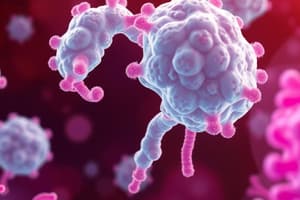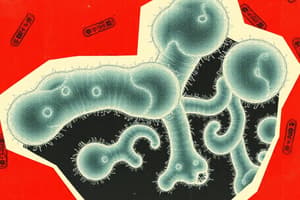Podcast
Questions and Answers
Which of the following biotypes of Corynebacterium diphtheriae exist?
Which of the following biotypes of Corynebacterium diphtheriae exist?
- Mitis (correct)
- Intermedius (correct)
- Toxigenic
- Gravis (correct)
Corynebacterium diphtheriae is a human pathogen that spreads by droplets.
Corynebacterium diphtheriae is a human pathogen that spreads by droplets.
True (A)
What type of infections can Listeria monocytogenes cause?
What type of infections can Listeria monocytogenes cause?
Invasive Infection, Septicemia, Meningitis, and Abortion
Which of the following is true about Bacillus cereus?
Which of the following is true about Bacillus cereus?
Diphtheria toxin is associated with _____ strains of Corynebacterium diphtheriae.
Diphtheria toxin is associated with _____ strains of Corynebacterium diphtheriae.
Bacillus anthracis can cause cutaneous anthrax.
Bacillus anthracis can cause cutaneous anthrax.
What is the key treatment for tetanus caused by Clostridium tetani?
What is the key treatment for tetanus caused by Clostridium tetani?
What is a common cause of food poisoning associated with Clostridium perfringens?
What is a common cause of food poisoning associated with Clostridium perfringens?
What is the primary mode of transmission for Clostridium botulinum?
What is the primary mode of transmission for Clostridium botulinum?
Flashcards are hidden until you start studying
Study Notes
Corynebacteria Group
- Pleomorphic Gram-positive bacilli, aerobic and part of normal flora in respiratory, urinary tract, and skin.
- Mostly nonpathogenic, with Corynebacterium diphtheriae as a human pathogen causing diphtheria.
- Diphtheria is highly infectious, spreading via droplets with asymptomatic carriers.
- Clinical features include throat inflammation, necrosis, and pseudomembrane formation.
- Toxigenic strains release Diptheria Toxin, leading to high mortality rates.
- Diphtheria vaccine (toxoid) administered to children at 2, 4, and 6 months.
- Diagnosis involves Albert's and Gram stain, throat culture on Blood Tellurite Medium, and testing for toxin production.
Listeria monocytogenes
- Gram-positive small bacilli with tumbling motility at lower temperatures.
- Asymptomatic carriers found in human intestines and vagina; common in animals.
- Causes listeriosis: invasive infections, septicemia, meningitis, and abortion.
- Diagnosed by observing typical tumbling motility in CSF direct smears.
Spore Forming Bacilli
- Gram-positive spore-forming bacilli are aerobic or anaerobic, resilient in dry environments, and commonly found in soil, water, and animal intestines.
- Generally saprophytic, with few pathogenic representatives.
Bacillus cereus
- Associated with food contamination (rice, meat); produces heat-stable enterotoxin.
- Causes food poisoning with vomiting and diarrhea; incubation period ranges from 1-24 hours.
- Treatment is supportive, no antibiotics needed.
Bacillus subtilis
- Small, motile, non-capsulated bacillus; opportunistic pathogen.
- Can cause wound infections and sepsis, especially in infants and immunocompromised individuals.
- Spores are used as a sterilization efficiency test for ethylene oxide.
Bacillus anthracis
- Large, non-motile rectangular bacilli, arranged in chains; produces oval, central spores.
- Infection occurs through contact with contaminated animals/products; causes cutaneous anthrax or inhalational anthrax with high fatality rates.
- Biological warfare agent; diagnosed by culturing specimens from skin ulcers or blood.
Clostridia Group
- Anaerobic, spore-forming, Gram-positive bacilli; mostly saprophytic with a few pathogens among them.
- Produce potent exo- and enterotoxins, which can be fatal without treatment.
Clostridium tetani
- Causes tetanus; highly fatal with high mortality rates due to potent neurotoxin (tetanospasmin).
- Spores germinate in necrotic tissue, leading to local multiplication and remote symptom manifestation.
- Treatment includes surgical debridement, antibiotics, antitetanic serum, and vaccination.
- Lab diagnosis is based on Gram-stain and culture of specimens from damaged tissues.
Neonatal Tetanus
- Often fatal in developing countries due to poor aseptic technique during childbirth, particularly at the umbilical stump.
Other Clostridia Species
- Some are toxigenic and invasive, producing enzymes like collagenase and hyaluronidase.
- Associated with deep wound infections, gas gangrene, myonecrosis, and bacteremia.
- Treatment involves surgical debridement, amputation, and antibiotics; there is no preventative vaccine.
- Clostridium perfringens causes food poisoning with enterotoxin, characterized by intense watery diarrhea without fever.
Clostridium botulinum
- Causes food-borne botulism via preformed toxin ingestion.
- Leads to paralysis by preventing acetylcholine release at neuromuscular junctions.
Studying That Suits You
Use AI to generate personalized quizzes and flashcards to suit your learning preferences.




